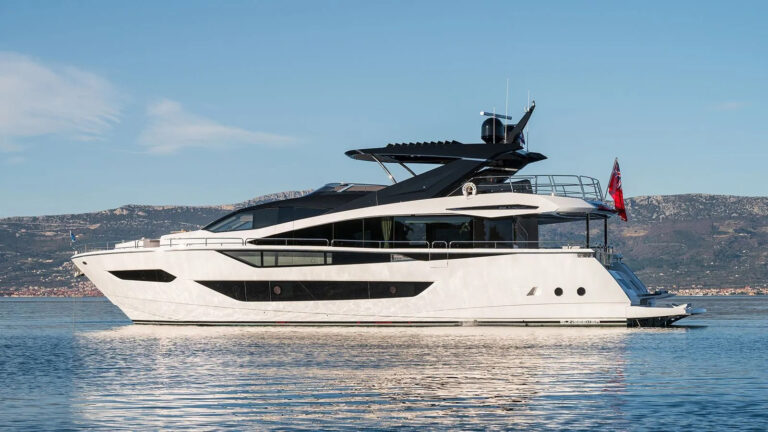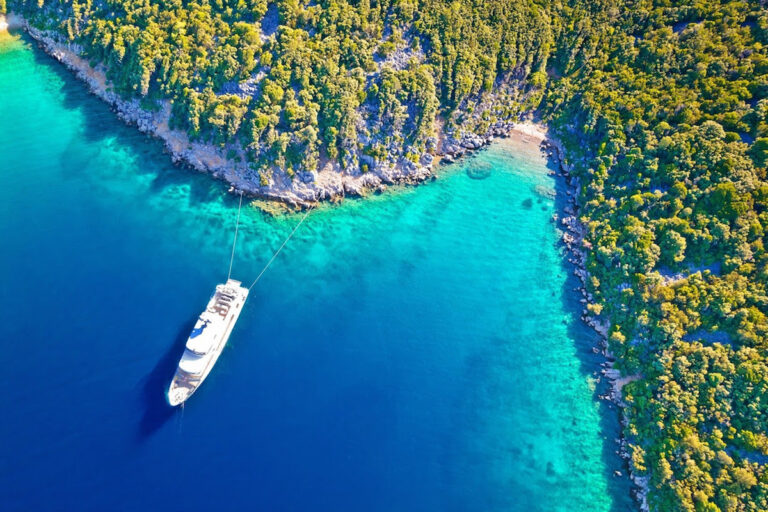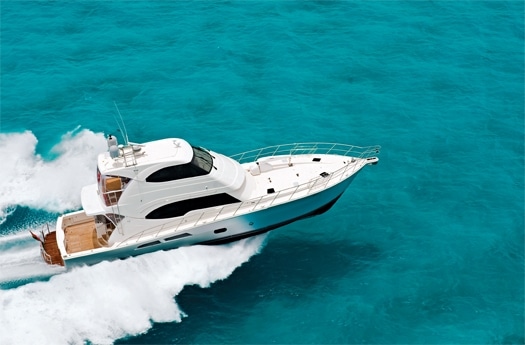
ytgjul14riviera70525.jpg
It wasn’t long ago that a convertible larger than 50 feet was an exception in the production market. This segment was left to the custom yards. Then Hatteras captured a market niche with a Hargrave-designed 60-footer in 1978, followed by the venerable 65 in 1986. Both became instant classics and blazed a trail for other builders. Today, every major production builder in the sportfish market has an offering in the 70-foot-plus range. Basically, 70 has become the new 50.
If your fishing and cruising plans call for long-distance expeditions to Venezuela, Panama, the ever-popular fishery of Costa Rica, or beyond, the benefits of a bigger convertible become obvious. Range and stowage for several months of provisioning are easily achieved. Do you want to carry a flats skiff forward for some bonefishing? No problem, thanks to a large foredeck.
However, some critics of larger convertibles will argue that, when landing big game, the maneuvering capabilities of larger designs can become an issue. I would counter that the angler should still do some of the work, and these critics haven’t been on the Riviera 70. During our test off Australia’s Gold Coast, I found she was as agile as some 50-footers I’ve run. She stays true even with one engine running and barely a touch of the wheel. When backing down, the upper station provided a great view of the cockpit. The stern reacted effortlessly to bumps of the throttles and took on minimal water in the six-foot chop going astern. She turned nearly within her own wake at wide open throttle, while barely losing any speed.

| | |
We galloped over the rollers while running from the mid 20s to about 35 knots and never felt uncomfortable. The 70 easily rose over the crest and settled softly into the trough with no noticeable creaking or protest. Even in a building six-foot swell with a few larger seas thrown into the mix, the 70 remained dry since the forward chine cast off the spray to the side just abaft the leading edge of the house.
Tournament enthusiasts looking to stay ahead of the pack will appreciate the nearly 35-knot top speed supplied by the twin 1,550-horsepower Caterpillar C32 diesels. Optional MTU Series 2000s are available if you want to add a little more speed. Even in the bigger seas, I found a sweet spot at 1,800 rpm, achieving a speed of 24 knots while burning 103 gallons per hour total. Inside the enclosed bridge, we recorded a whisperquiet decibel reading of 68. For a frame of reference, the normal level of conversation is 64.
Our test boat, which was hull number three, had a sunroof on the enclosed bridge. Yes, I can hear more rumblings from the purist crowd. But take it from this stick-in-the-mud, it works. The space is opened up to reveal sun and air and is designed to negate any wind rush.
Enclosed bridges are another item that can fuel a debate along the docks. On a 70-footer, however, I just think it makes more sense than an open bridge. For starters the scale of a bridge on a larger convertible is big enough that the line of sight can be compromised, and often the sides of the boat are out of view. On the Riviera, the helm was all the way forward, on the centerline, and offered good lines of sight. The helm console itself rivaled that of a 100-foot-plus yacht with enough room for an aircraft carrier worth of electronics.
Another reason, in my opinion, for going with an enclosed bridge on a larger boat is that the design is simply mission-specific to a big convertible. Would you rather serve long overnight watch schedules off the Mona Passage on an open-bridge layout, or sit back in a climate-controlled environment in a plush helm chair? Do want a bottle of water at 2 a.m? Just reach back to the wet bar. If you’re like me and have an off-watch crew close at hand during a long passage, you’ll be pleased to know that the L-shaped settee on the bridge could serve as a comfortable berth as well.
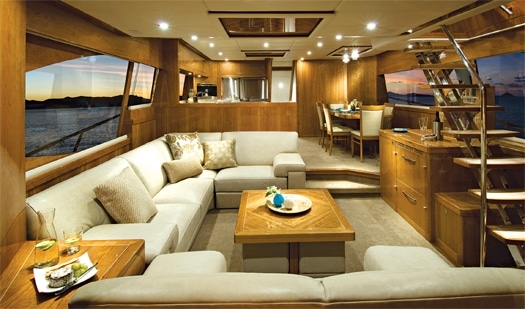
| | |
A hatch can be dogged down between the bridge and the staircase to the salon. This provides an element of safety. In addition, thanks to the amenities and comfort of the bridge, the area could serve as a second, out-of-the way salon if you intend to cruise with a crew or large family.
Riviera offers several different cockpit options. Our test boat had a spacious mezzanine deck. Another option offers two facing settees and a table for alfresco dining. Obviously, one option is more fishing-focused and the other is more oriented to the cruiser. Yet it demonstrates the versatility of a convertible design and the flexibility of Riviera. In addition, anglers looking to dial up their 70 to be more in line with the custom girls can forgo the nearly full bow pulpit, side rails and swim platform. The cockpit is outfitted with a freezer, fishbox, and grill, and can be equipped with a transom bait well.
If I were asked to summarize the belowdecks arrangement plan in a short sentence, I would just say that it works perfectly. The proportions, use of space, natural light, functionality, and fit and finish are just dialed in. The after bulkhead between the salon and aft deck opens up to the mezzanine deck to make everyone part of the action. Even when closed, guests can sit at the settee and watch baits.
The galley is huge with four drawer-style refrigerator/freezers and two more at the salon wet bar. Riviera will work closely with the buyer on this configuration and can accommodate more freezer or refrigerator space depending upon the buyer’s needs. A utility room just forward has a combo washer and dryer and a trash compactor. A full dining table next to the utility room seats eight.
Several alternative stateroom layouts are available. Again, the fourhead, four-stateroom layout of our test boat worked well. The fullbeam master is on the centerline, forward of the engineroom.
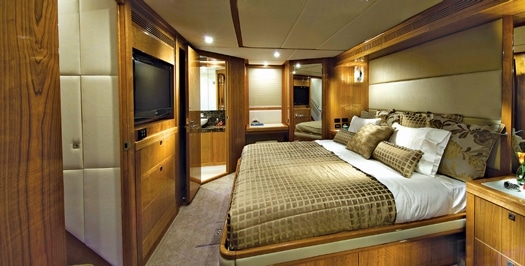
| | |
There are certainly a number of convertible offerings to choose from now in this size range. If long-distance cruising or fishing is on your horizon, I encourage you to head Down Under. Riviera continues to build a quality yacht and with the 70, the builder is willing to work with each individual owner, which creates some interesting possibilities.
The Riviera Group, (772) 403-1060; **www.riviera.com.au**






